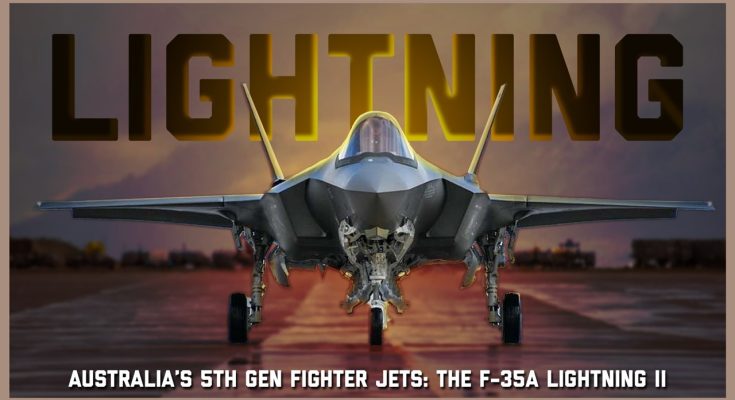Australia’s F-35A Lightning II is widely regarded as one of the most technologically advanced fighter jets in the world. This cutting-edge aircraft, a variant of the globally renowned F-35 Lightning II, stands at the forefront of modern military aviation, representing a major leap forward in terms of stealth, sensor fusion, and versatility. With its advanced capabilities, the F-35A provides the Australian Defence Force (ADF) with a significant strategic advantage, reinforcing the country’s defense posture and enhancing its interoperability with allied forces.
The F-35A: A Technological Marvel
The F-35A is part of the Joint Strike Fighter (JSF) program, developed by Lockheed Martin. It is a fifth-generation multi-role stealth fighter designed to perform a range of missions, from air superiority and close air support to intelligence, surveillance, and reconnaissance (ISR). The F-35A is specifically tailored for conventional takeoff and landing (CTOL) operations, making it ideal for deployment from traditional airbases and aircraft carriers.
One of the most defining features of the F-35A is its stealth technology. The aircraft’s design minimizes its radar cross-section, allowing it to evade detection by enemy radar systems. This is achieved through a combination of radar-absorbing materials, advanced shaping, and specialized coatings that make it nearly invisible to adversary sensors. The F-35A’s low observability allows it to penetrate sophisticated air defense systems and carry out high-priority missions without being easily detected.
Sensor Fusion and Situational Awareness
The F-35A is equipped with an unprecedented array of sensors that give it a unique edge in the modern battlefield. The most important of these is the AN/APG-81 AESA radar (Active Electronically Scanned Array), which provides long-range detection and tracking of both air and ground targets. In addition, the aircraft is fitted with an advanced Distributed Aperture System (DAS) that provides 360-degree situational awareness, allowing pilots to detect and track threats from any direction. This system also feeds infrared imagery directly to the pilot’s helmet-mounted display, ensuring that the pilot has a clear, real-time view of the battlespace.
The Electro-Optical Targeting System (EOTS) further enhances the F-35A’s targeting capabilities, enabling precision strikes in both air-to-air and air-to-ground operations. The fusion of these sensors into a single operational picture greatly enhances the pilot’s situational awareness, allowing for quick decision-making and precise targeting even in highly contested environments.
Advanced Cockpit and Helmet-Mounted Display
A key element of the F-35A’s technological edge is its cockpit and helmet-mounted display system (HMDS). The helmet-mounted display projects critical flight data, targeting information, and sensor feeds directly onto the pilot’s visor, eliminating the need for traditional cockpit displays. This revolutionary system enables pilots to “see through” the aircraft, allowing them to view the terrain and targets as though they were transparent. The enhanced situational awareness provided by the HMDS is especially useful in complex, high-threat environments, where split-second decisions can be the difference between success and failure.
Versatility and Multirole Capabilities
While the F-35A is primarily designed as an air superiority fighter, its versatility is one of its most impressive features. It can carry out a wide range of missions, including close air support, precision strike, intelligence gathering, and electronic warfare. Its ability to carry a combination of internal and external payloads, including a variety of precision-guided munitions, allows it to engage a wide array of targets with extreme accuracy. The internal weapons bay helps maintain the aircraft’s stealth profile by minimizing drag and radar visibility when carrying munitions.
Australia’s Strategic Advantage
Australia’s acquisition of the F-35A has positioned the country at the cutting edge of global military aviation. The Royal Australian Air Force (RAAF) operates one of the most advanced fleets of F-35A fighters in the world, which enhances its capabilities in both defense and international operations. With a total of 72 F-35A aircraft planned, Australia’s commitment to the F-35 program is a testament to its investment in modernizing its defense forces and ensuring its ability to respond to evolving security threats.
The F-35A also strengthens Australia’s interoperability with allied forces, particularly the United States, which operates a large fleet of F-35 aircraft. This ensures that Australian forces can seamlessly integrate into multinational operations, sharing intelligence and coordinating missions with partner nations in the Indo-Pacific region and beyond.
Conclusion
Australia’s F-35A Lightning II stands as one of the most technologically advanced fighter jets in the world, offering unmatched capabilities in stealth, sensor fusion, and versatility. With its cutting-edge technologies, the F-35A provides the Royal Australian Air Force with a significant strategic advantage, enhancing both national defense and international cooperation. As global security dynamics continue to evolve, the F-35A will remain a cornerstone of Australia’s defense strategy, ensuring the nation is prepared for the challenges of tomorrow’s aerial warfare.



